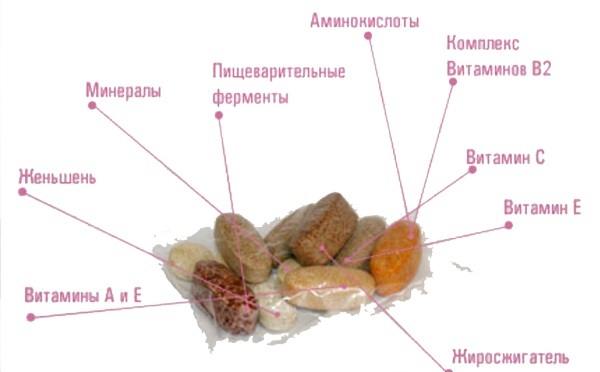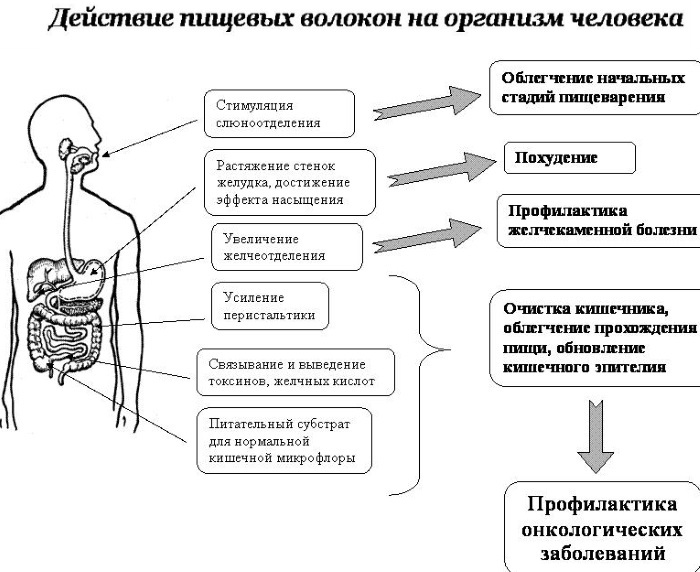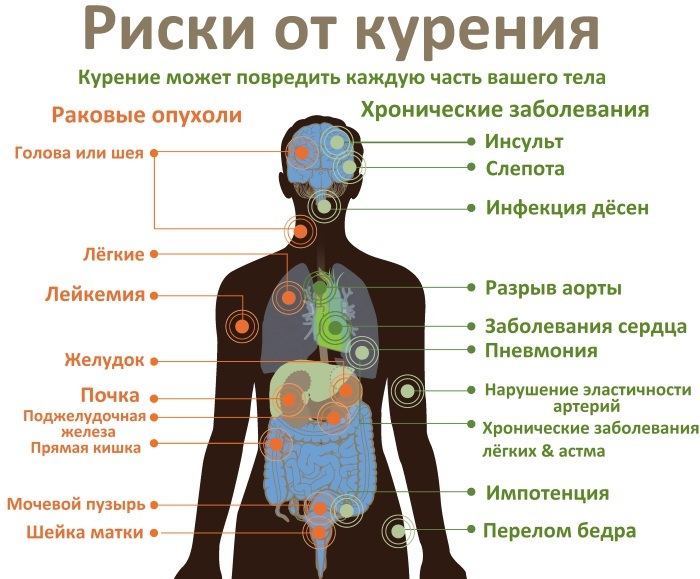Content
- Smoking
- Short term
- Long term
- During pregnancy and hepatitis B
- How to get rid of
- Alcoholism
- Short term
- Long term
- During pregnancy and hepatitis B
- How to get rid of
- Addiction
- Short term
- Long term
- During pregnancy and hepatitis B
- How to get rid of
- Video about bad habits
Addiction leads a person to self-destructive behavior. This process is the result of the interaction of biological causes (for example, a weak nervous system), environment and psychological factors. According to doctors, genetics accounts for 1-2% of the risk of developing addictions.
A person who is addicted to addictions gradually leaves his interests, daily activities, and obsessively immerses himself in the world that gives him pleasure. However, he is not aware of the consequences of bad habits. And as a result, there is a serious deterioration in health, social and work life.
Smoking
Nicotine is the main addictive chemical in tobacco. It promotes the release of adrenaline when absorbed into the bloodstream or inhaled. Nicotine also causes an increase in dopamine levels, which stimulates the pleasure-related area of the brain. Over time, tobacco can cause physical and psychological dependence. This also applies to smokeless forms such as snuff and chewing tobacco.
The more a person smokes, the more nicotine they need to feel good. Trying to get rid of the habit, a person experiences unpleasant mental and physical changes. These are symptoms of nicotine withdrawal.
The consequences of bad habits for a person who abuse nicotine are obvious.
People who smoke cigarettes are more likely to get diseases:
- lungs' cancer;
- cardiovascular disorders;
- diabetes;
- eye problems;
- infertility and impotence;
- colds, flu and other illnesses, since smokers are prone to respiratory infections;
- diseases of the teeth and gums.
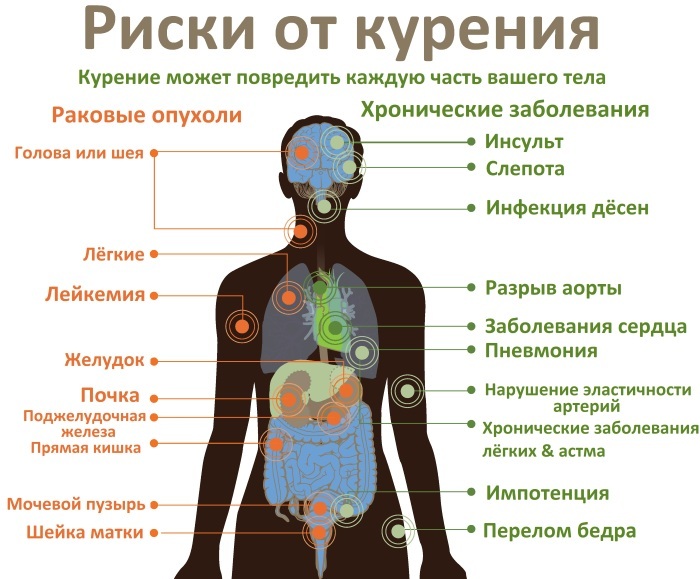 Smoking also poses a health hazard to those around you. Non-smokers and partners of smokers have an increased risk of lung cancer and heart disease compared to people who do not live with smokers. Children whose parents smoke are more likely to have exacerbations of asthma, ear infections, and colds.
Smoking also poses a health hazard to those around you. Non-smokers and partners of smokers have an increased risk of lung cancer and heart disease compared to people who do not live with smokers. Children whose parents smoke are more likely to have exacerbations of asthma, ear infections, and colds.
Short term
After quitting nicotine, a person experiences withdrawal symptoms due to the fact that the brain no longer receives the chemical on which he became addicted. People start to feel overwhelmed the very first day they quit smoking. These feelings last for several weeks and usually go away within a month. However, some patients with a history of depression may experience more severe symptoms.
According to the WHO, after smoking the last cigarette, the body begins to recover:
- In 20 minutes after stopping smoking, the pulse and blood pressure are restored to normal.
- 12 hours after refusal, the level of carbon monoxide in the blood is close to normal.
- Between 2 weeks and 3 months after quitting smoking, blood circulation and lung function improve.
- After 9 months, coughing and shortness of breath decrease.
The consequences of bad habits for a person, even in the case of a short-term quitting smoking, lead to the development of negative symptoms:
- dizziness;
- insomnia;
- headaches;
- tiredness;
- decrease in heart rate;
- nausea;
- constipation;
- dry mouth;
- tremor;
- nervousness;
- poor sleep;
- trouble concentrating.
Long term
In the following months after quitting nicotine, the general condition begins to improve.
| 1 year after quitting smoking | The increased risk of coronary heart disease is half that of those who still smoke. The risk of a heart attack drops dramatically. |
| After 5 years | The risk of cancers of the mouth, throat, esophagus and bladder is halved. The risk of cervical cancer drops to the level of non-smokers. |
| 10 years after quitting smoking | The risk of dying from lung cancer is about half that of someone who still smokes. Reduces the risk of cancer of the larynx and pancreas. |
| 15 years after quitting smoking | The possibility of developing coronary heart disease is equal to the development of the disease in nonsmokers. |
| 20 years later | The risk of death from causes associated with smoking, including lung disease and cancer, is reduced to the level of a person who has never smoked in his life. |
Many symptoms disappear after nicotine withdrawal, but some negative manifestations remain with the person for a long time: craving for weight gain, changes in vision, anxiety, depression, irritability.
During pregnancy and hepatitis B
Many women want to quit smoking during pregnancy, but most of them need help. Research shows that behavioral therapies are most effective, while pharmacotherapy has only marginal success. The combination of attractive incentives and behavioral counseling works well for pregnant women.
The effects of smoking during pregnancy are associated with a number of adverse outcomes that affect the newborn:
- low birth weight of the child;
- limited head growth;
- problems with the placenta;
- increased risk of stillbirth;
- increased risk of miscarriage.
A harmful habit that a woman did not give up during the prenatal period is also associated with other consequences for the health and development of children, including:
- decreased lung function, persistent wheezing and asthma;
- vision problems such as strabismus, refractive errors (blurred vision), and retinopathy (changes in the retina).
How to get rid of
Among the many treatment options for nicotine addiction, the most significant are: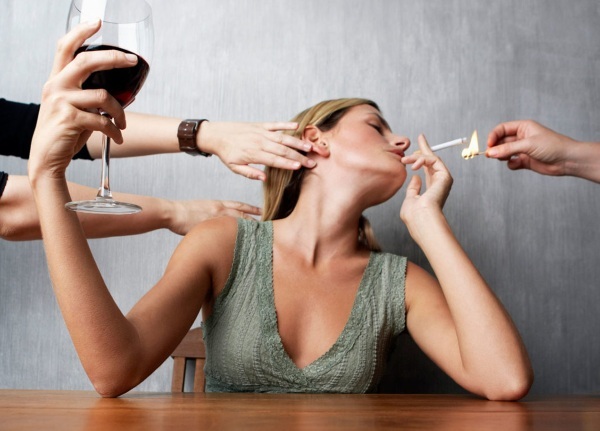
Medication methods | |
Varenicline, |
The drug partially triggers a specific receptor in the brain that only responds to nicotine and blocks it. |
| Bupropion | An antidepressant is used to reduce nicotine cravings. |
| Nicotine replacement therapy | |
Nicotine patch |
This drug releases nicotine slowly and keeps nicotine levels low throughout the day. |
| Nicotine chewing gum | It can be combined with a patch for patients with strong food cravings. |
| Oral nicotine inhaler | Nicotine and menthol cartridges can be combined with nicotine patch. |
| Nicotine nasal spray | This form of nicotine reaches the brain faster than chewing gum, lozenges, and inhaler. |
| Nicotine lollipops | The lollipop is placed in the mouth and slowly dissolves, so nicotine is absorbed through the oral mucosa within 20-30 minutes. |
In the event that all of the listed methods of first-line therapy do not bring success, then further treatment includes:
- consultations and psychological support of a doctor;
- individual or group therapy.
The greatest benefit comes from drugs supported by counseling and mental health care.
Alcoholism
With the development of alcoholism, not only abusers experience discomfort, but also the people around them experience inconvenience. Family members also develop organic and psychological disorders just because one of them is abusing alcohol. The WHO defines alcoholism as a disease that affects the entire family.
Alcohol adversely affects many organs of the body. Medical complications can range from acute injury to the stomach lining to serious damage, such as chronic liver disease, infertility, and loss of intellectual functions.
Physical illness, organic or psychological, can occur in children who become more fragile and vulnerable.
Short term
The schedule for getting rid of the addiction will depend on how severe the level of alcoholism is and how long the person has been drinking.
The process of alcohol withdrawal and recovery is broken down into several distinct phases.
- Acute cancellation. The acute abstinence stage is the first test to be passed. Some of the early withdrawal symptoms will appear as early as 6 hours after the last drink. These include:
- increased sweating and increased body temperature;
- increased blood pressure and heart rate;
- tremor;
- insomnia and anxiety.
The consequences of bad habits for a person are always negative and can lead to seizures and a condition called alcoholic delirium.
- Post-acute withdrawal symptoms. Complete detoxification can take up to 2 weeks. At this stage, the psychological consequences of quitting alcohol usually become more pronounced. Some of the common symptoms that are felt during this time include:
- decreased energy;
- feelings of anger and aggression;
- general anxiety and depression;
- difficult sleep;
- decreased libido.
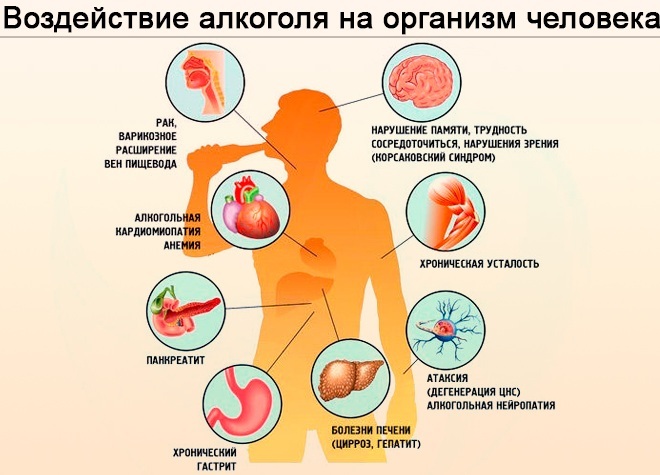
These symptoms will last from several weeks to a year, depending on the severity of the alcohol dependence.
- From 1 month and longer. A month after quitting alcohol, the patient can cope with most of the unpleasant symptoms. At this stage, it is recommended to start new healthy habits. During this time, you can seek advice from a psychotherapist to ease the transition period and get rid of negative psychological states that were the cause of alcoholism.
Long term
The transition to a life without alcohol can be difficult. The body and mind must go through a regulatory process in order to return to the body's natural balanced chemistry. During this period, you should contact the treatment center, which provides consultations, in order to consolidate healthy habits and maintain a normal lifestyle.
The support of a psychotherapist is essential to prevent relapse. Recurrence of drug or alcohol addiction after a period of remission or recovery is common among people with diagnosed psychoactive use disorders substances.
During pregnancy and hepatitis B
Alcohol in the mother's blood passes to the baby through the umbilical cord, so drinking alcohol during pregnancy can cause miscarriage, fetal death and various lifelong physical, mental and behavioral disorders in child.
- Babies may show slow growth and developmental delays, unusual facial features, irritability, neurological disorders, and mental retardation.
- School-age children may have learning problems, low tolerance for others, and reading difficulties.
- Puberty is marked by depression, anxiety, and inappropriate sexual behavior.
How to get rid of
Some people quit alcohol on their own or through psychological support programs. Others need medical supervision to safely and comfortably return to their normal lives. Which option is better depends on how long the person has been drinking, on the stability of the life situation and health problems.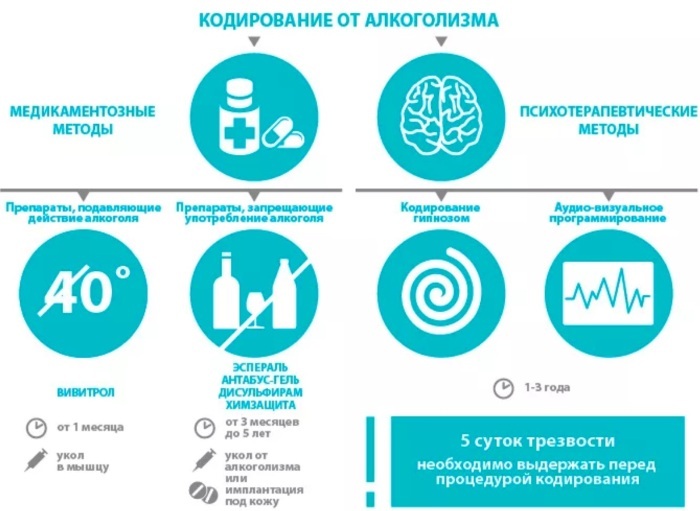
- Inpatient treatment involves intensive care for 21 days.
- Partial hospitalization is intended for people who need constant medical supervision, but have a stable life situation. These treatment programs are usually carried out in a hospital 3-5 days a week for 4-6 hours a day.
- Intensive outpatient programs focus on relapse prevention.
- Therapy (individual, group, or family) helps identify root causes of alcohol use, build relationships, and teach healthy skills.
Addiction
Drug abuse is a chronic, relapsing brain disorder associated with compulsive search for and use of drugs.
There are many factors that contribute to addiction, including genetic makeup, family origins, social influences, neurological factors, and environmental problems.
However, the medical community recognizes that addiction is a brain disease, not a character flaw. Repeated use of drugs such as heroin, cocaine, methamphetamine, or prescription opiates causes profound changes in brain structure and function. These substances affect how the brain processes neurotransmitters, chemicals that control emotions, energy levels, pain response, judgment, sleep patterns, and metabolism.
The longer a person uses drugs, the more the brain and nerves begin to rely on these substances to induce feelings of pleasure, excitement, relaxation, or euphoria. Addiction occurs when repeated use of the drug changes the brain in such a way that the user can no longer function normally without it.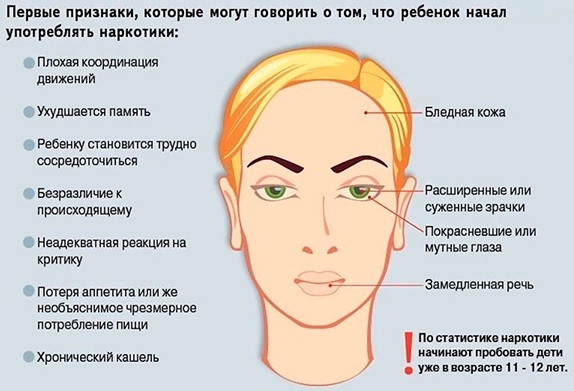
The consequences of bad habits for a person taking psychoactive substances:
- Impaired immune system - increased susceptibility to various infections.
- Cardiovascular disease, including heart attacks and venous collapse.
- Nausea, vomiting, abdominal pain.
- Liver failure.
- Convulsions and convulsions.
Chronic drug use alters the structure and function of a person's brain, leading to long-term psychological consequences:
- depression;
- anxiety;
- panic disorder;
- increased aggression;
- paranoia;
- hallucinations.
Long-term drug use can also affect a person's memory, learning, and concentration.
Short term
Refusal from the drug can last from several days to a week or more. Some of the late signs of drug withdrawal, such as anxiety, depression, and cognitive impairment, may persist after the detoxification phase.
The duration and severity of withdrawal symptoms are influenced by many factors, including:
- With the abuse of opiates (heroin, morphine, oxycontin, vicodin) withdrawal symptoms usually begin within a few hours and last for several days.
- With stimulants such as cocaine or methamphetamine, withdrawal symptoms can be more extensive and include drug cravings, depression, and anxiety lasting several months.
- Avoiding prescription drugs that belong to the benzodiazepine group may require you to gradually taper the dose of the drug to safely remove the chemicals from your body.
Long term
Like any other life-threatening disease, drug addiction requires intensive treatment by qualified professionals. While some addicts may find their way to recovery alone, true healing is a lifelong process that requires ongoing support.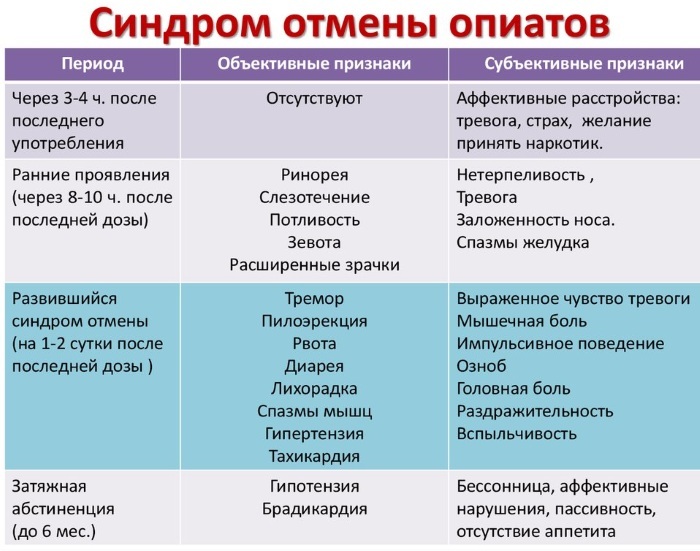
Some changes persist for a long time after stopping the drug:
- insomnia;
- anorexia;
- decreased libido;
- aggressive behavior;
- cerebrovascular disorders;
- auditory and visual hallucinations;
- psychosis.
Other additional risks are associated with the appearance of phlebitis or skin abscesses, or the possibility of contracting infectious diseases (AIDS, hepatitis B and C, tetanus).
During pregnancy and hepatitis B
Using illegal drugs such as cocaine and methamphetamines can lead to low birth weight babies, birth defects, or withdrawal symptoms after birth.
How to get rid of
Addiction treatment can vary, but a successful program includes the following elements:
- Detoxification. Usually, the first step is to clear the drug from the body and eliminate withdrawal symptoms.
- Behavioral counseling. One-to-one or group conversation can help build relationships and teach healthy coping skills.
- Pharmacotherapy is used to treat withdrawal symptoms, prevent relapse, or treat any comorbid mental condition such as depression or anxiety.
- Long-term follow-up helps prevent relapse.
Types of drug addiction treatment:
- Inpatient treatment includes intensive care, round-the-clock monitoring and a full range of rehabilitation services for patients. The course of treatment can last from several days to several months.
- Partial hospitalization is for people who need constant medical supervision but wish to continue to live at home.
- Outpatient treatment involves a course of therapy in the afternoon or evening. The focus is on relapse prevention. Outpatient treatment is suitable for those who have undergone inpatient therapy.
Since any addiction is a chronic disease, a person needs long-term treatment, psychological support in order to realize the consequences of bad habits, completely abandon them and rebuild your life.
Video about bad habits
The most bad habits:

